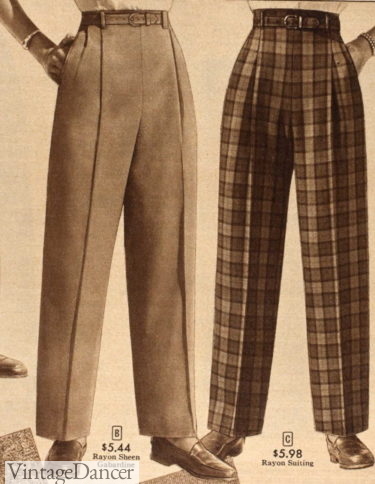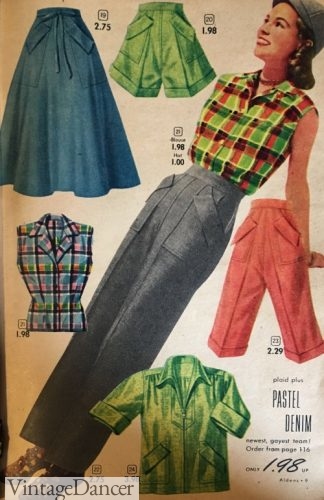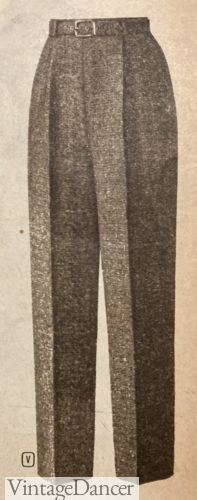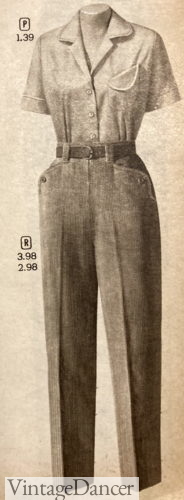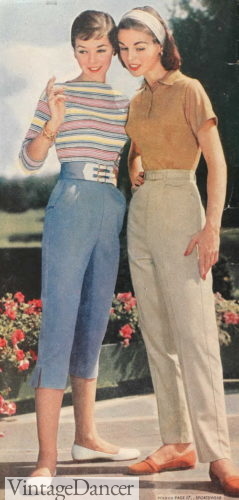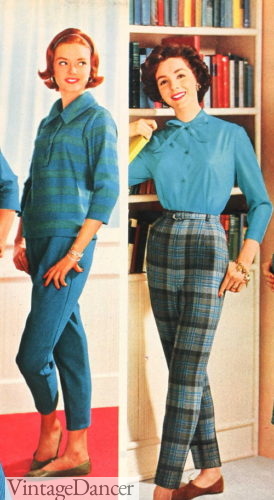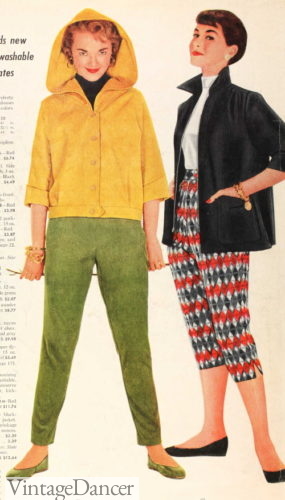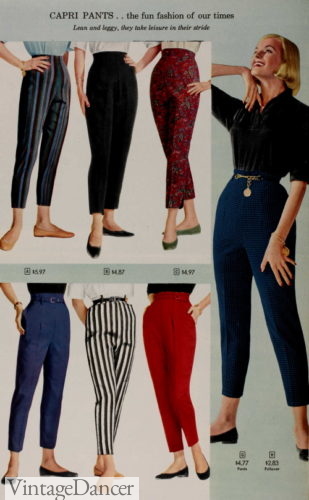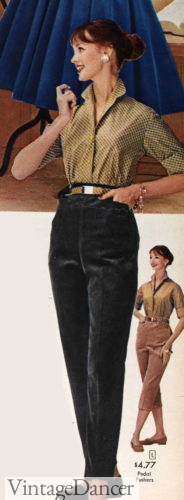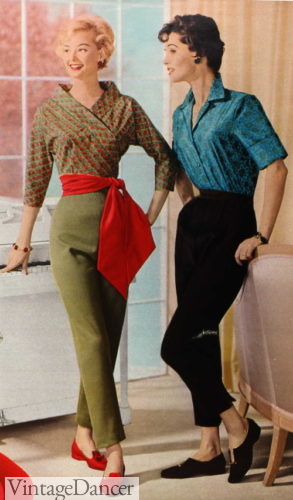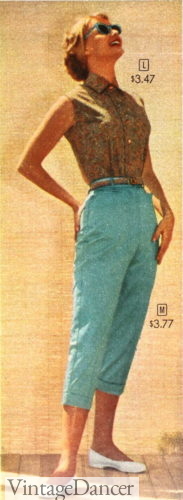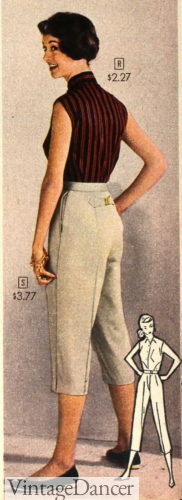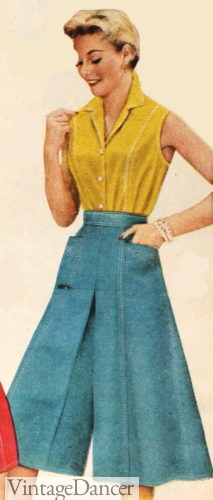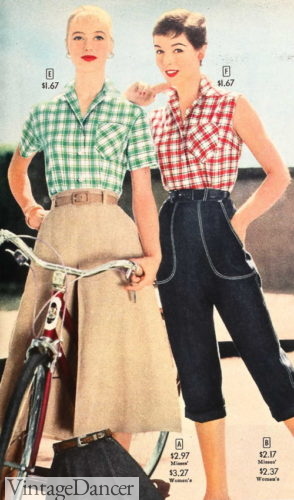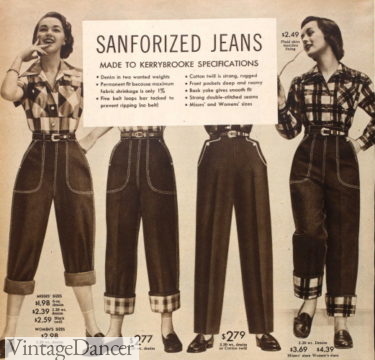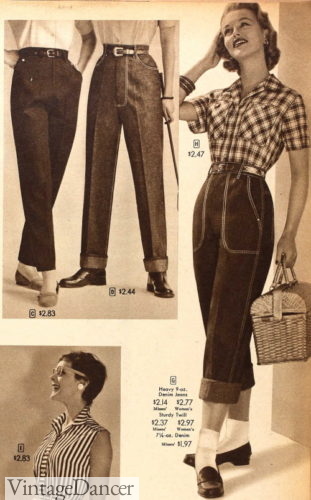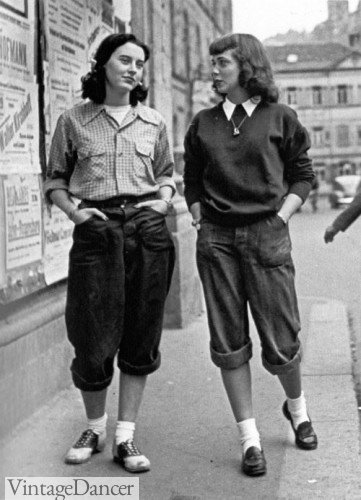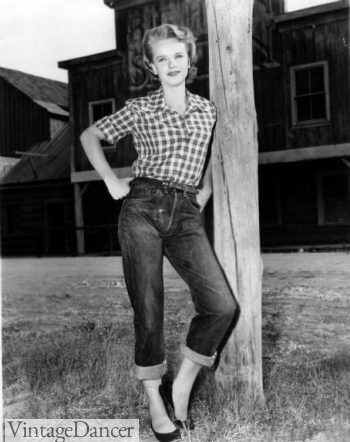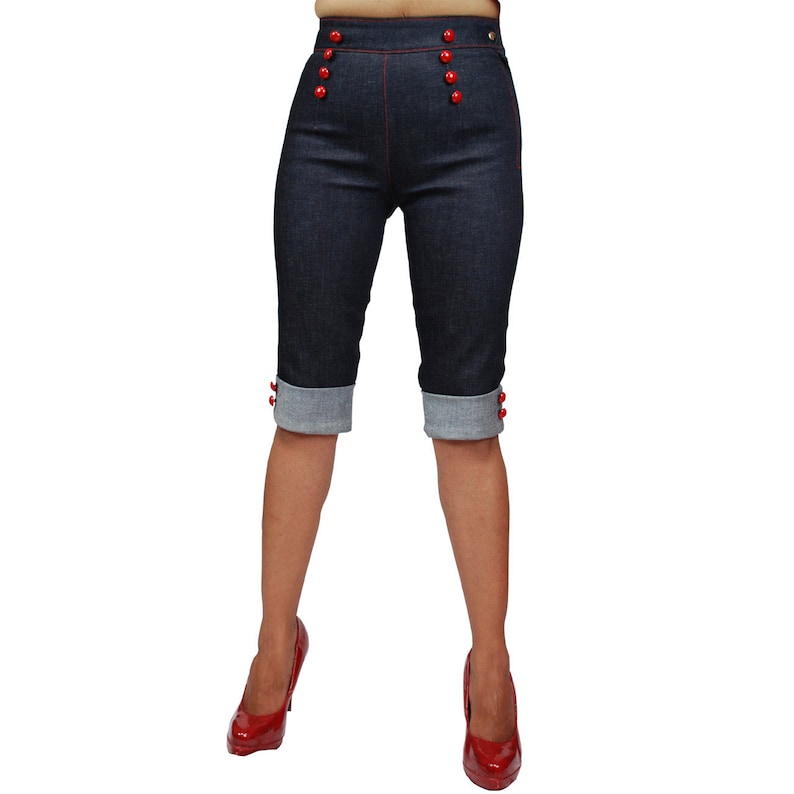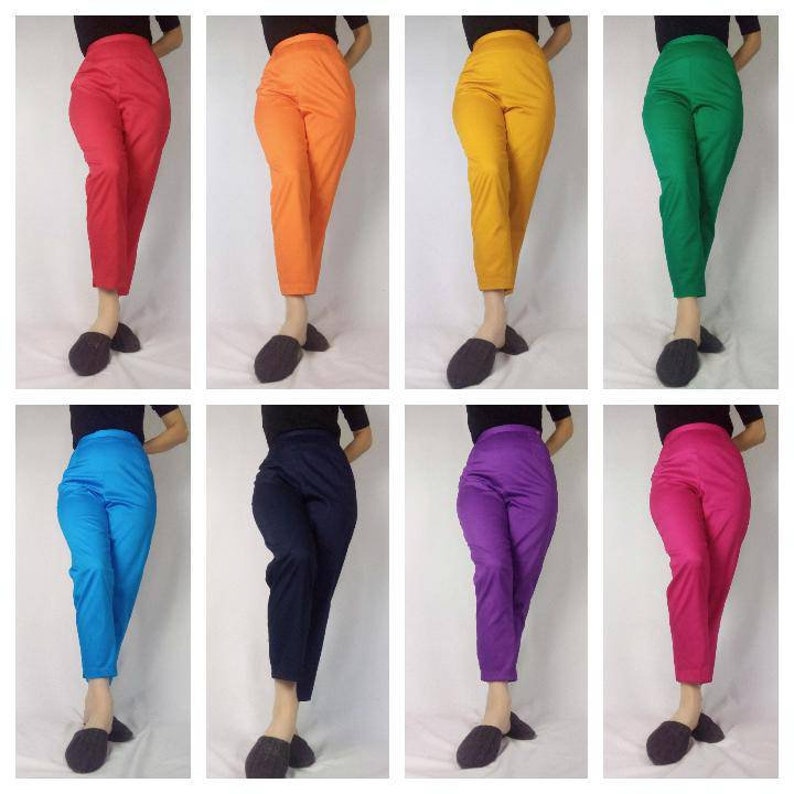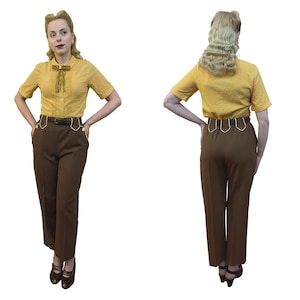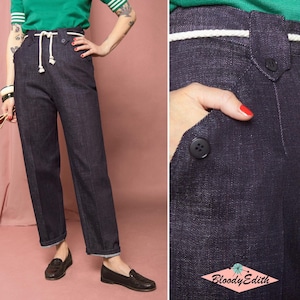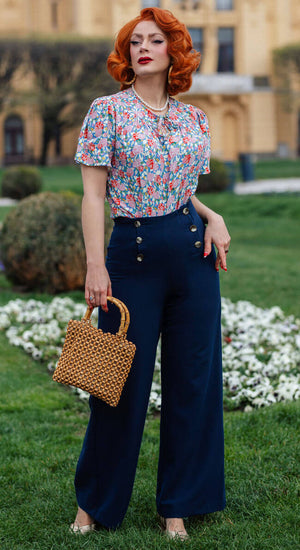Women in the 1950s were the first to embrace pants built for a feminine figure. While the women in the 1940s loved their man tailored slacks, they were gradually losing favor in the 1950s for a more ladylike style.
There are three popular styles of 1950s women’s pants. 50s pants were called tailored slacks, cigarette pants and capri pants. Women’s 1950s blue jeans and western jeans have their own category we will also learn about.
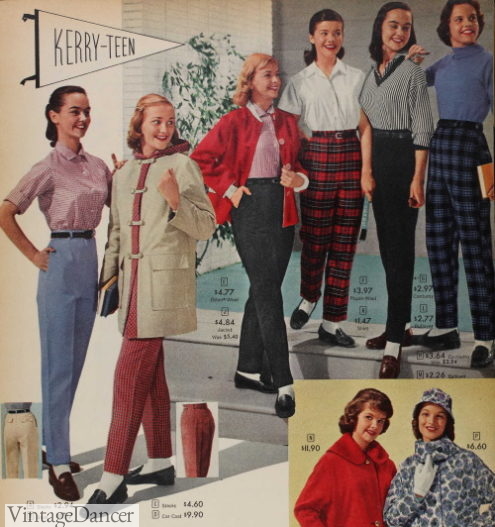
1959 Teens’ Pants Outfits
Women’s 1950s pants were taboo on TV. 1950s women were secretly wearing pants at home, but it wasn’t until they were prominently seen on TV that they felt comfortable wearing them outside of the home, too.
Lucille Ball and Vivian Vance wore pants from time to time on I Love Lucy in the early 1950s, but it wasn’t until Mary Tyler Moore was frequently seen wearing them on The Dick Van Dyke Show in her home starting in 1961 that women publicly acknowledged they wore pants.
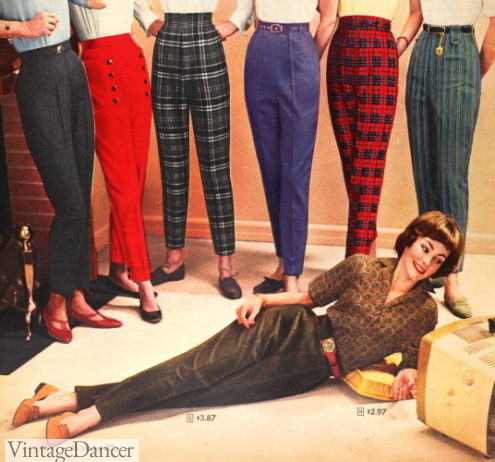
1959 Winter Pants, Solid and Plaid Patterns
1950s Tailored Slacks
Women’s wide leg 1940s pants were still worn into the early ’50s, but now they had a more tailored fit, higher crotch, and two simple pleats. Slacks were still side zipping, never a front fly like men’s trousers.
A belted waistband was more frequently seen in newer fabrics such as rayon, gabardine (matte or sheen), as well as in classic wool flannel and cotton twill.
- 1953 Simple Pleated Slacks
- 1953 Tailored Fit, Belted Slacks
In the 1950s, women’s pants came in classic colors such as black, brown, grey, and navy. Western inspired colors were making pant wearing more fun: deep gold, copper rust, cobalt blue, forest green.
Plaids of red/black/blue/white were one of the newest patterns, while small checks of black or brown were carryovers from the 1940s.
- 1952 Slacks and Plaid Pants
- 1952 Wide Leg Pants
In the mid 1950s, the emphasis was on textured fabrics instead of only color. Tweed (made of rayon or wool) and cotton corduroy were both fashionable women’s 50s pants materials in winter.
What about summer pant fabrics? Cotton twill, always a durable summer fabric, came in a nice variety of colors such as turquoise, pink, white, red, and navy blue.
- 1955 Tweed Slacks
- 1955 Corduroy Pants with Button Down Pockets
- 1954 Cotton Twill Slacks with a Coin Pocket
1950s Cigarette Pants
In 1955, women’s fashion took a major jump into a new, very fitted and sleek pant. 1950s pants were called many names including tapered pants, Italian style, Jax pants (LA designer brand), and capri pants.
History would remember them as 1950s Cigarette pants defined by a high waist, side or back zippers, a flat front across the hips, wide waistbands (3 inches), full hips, and a slim fitting tapered leg down to the ankles.
1950s women loved how cigarette pants flattened out a tummy and made legs look longer and leaner.
- 1957 Cigarette Pants (R)
- 1959 Cotton Knit and Plaid Wool Pants
Women’s 1950s cigarette pants made of wool or cotton were always lined. Having baggy knees was taboo, so lining helped keep the leg straight and wrinkle free.
It wasn’t uncommon for wool to stretch out of shape or linings to bust open with frequent knee bending. An outwardly perfect, good pair of pants could be ruined by a shredded mess on the inside.
- 1955 Cigarette Pants (L) Capri (R)
- 1958 Cigarette Pants
“Black capris were the answer to most casual what-to-wear problems.” – What to Wear
The best color of 50s Cigarette pants was black. Brighter colors were reserved for ankle length capri pants and sport shorts.
In the later 1950s, more patterns like polka dots, checks, stripes, plaid, and leopard prints appeared on casual cigarette pants.
Belts and belt loops were considered too masculine, yet some brands added a thin leather belt placed in the center of the waistband.
Add a wide white belt over black slacks and a colored blouse, and the outfit was exactly like what fashion icon Audrey Hepburn would wear.
- 1957 Corduroy Pants
- 1958 Sateen Cigarette Pants
Another ethnic style of women’s 50s pants was borrowed from the Spanish matador. Black pants paired with a white ruffled blouse, a Spanish cummerbund or large scarf sash, and an optional bolero jacket put the long Toreador pant into a slightly more formal category.
Adding a bi-corn hat put Toreador pants outfit even closer to a costume look, but women didn’t care. Mixing any of these elements with dresses and suits turned one outfit into many.
- 1959 Orange Pants with Green Sash Belt
- 1958 Black and Olive Pants with Red Sash
1950s Capri Pants
Pants in the 1950s were called ‘capris’ regardless of length. This is confusing today, since we tend to call cropped pants capris and full length pants ‘pants’ or ‘trousers.’
1950s capri pants fit like cigarette pants, except they ended a few inches above the ankle. Once they rose up to mid-calf, they became pedal pushers.
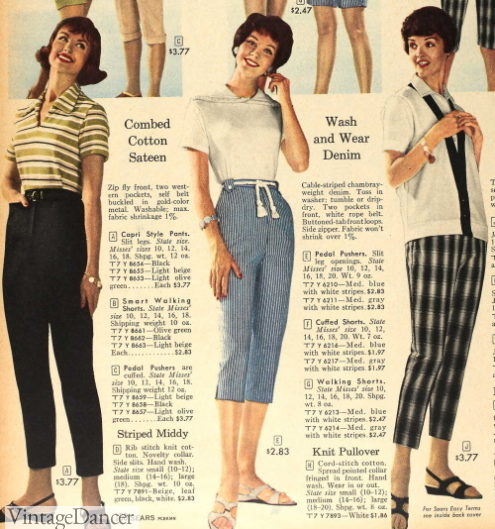
1959 Capris (R and L) and Pedal Pushers (Middle)
Black or white 1950s pants coordinated with all colors tops easily, but they were especially popular with striped shirts.
Striped knit shirts were called Italian or Roman shirts. A red and white shirt with black Capris certainly looked very Italian. Pairing it with blue pants gave a nautical look, like summer clothes on the Italian Riviera. To look European was a big deal in the ’50s.
1950s white capri or pedal pusher length pants with a wide folded hem were also called Yachting pants, yet another reference to summertime in Italy.
- 1957 Black Capris and a Striped Top
- 1957 White “Yachting” Pants with a Nautical Top
1950s Pedal Pusher Pants
Capris pants took on other names in the 1950s as different lengths created new styles.
Pedal pushers were an ‘in between shorts and pants’ style. They came to an inch or two below the knee, but still had the classic high waist and flat front that cigarette and capri pants had.
Some fun details were added to give 1950s pedal pushers a more casual look, such as a belt back (Ivy League styling), contrasting cuffs and pockets, white piping, white buttons, nautical themed embroidery, and much more.
- 1953 anchor themed pedal pushers
- 1958 teal blue pedal pusher capris
- 1958 Belt back “Ivy League” style
Manufacturers came up with many different names for these 3/4 pants, such as Motor scooter slacks, calypso pants, and pirate pants.
Another in-between shorts and pants style in the 1950s was Culottes. They had been around since the 1930s in an unchanged shape of wide leg pant that looked like a skirt with legs standing together.
Colored denim was what the majority of 1950s culottes were made of. Teal blue, olive green, khaki tan and white as well as dark denim blue.
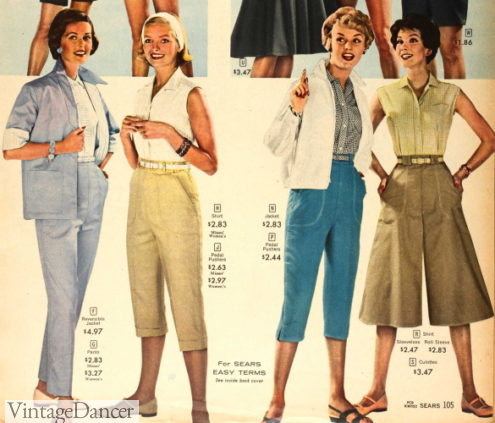
1959 Capris, Pedal Pushers, and Culottes Pants
1950s culottes were the perfect pant to wear for active sports such as bicycle riding and roller skating. Many western riders wore them as part of a show uniform at rodeos and guests bought them at dude ranch vacation camps.
- 1955 teal culottes with pockets
- 1957 tan denim culottes and pedal pushers
Moving up above the knee created women’s 1950s shorts, which varied from long to short shorts. Learn more about 1950s shorts and summer clothes here.
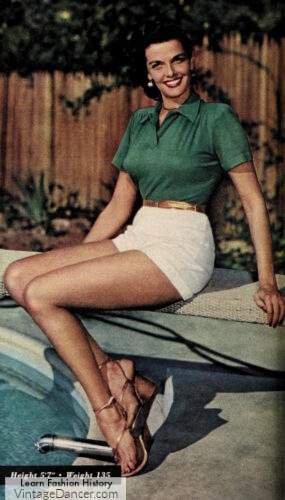
1951 Jane Russel shorts
1950s Jeans for Women and Teens
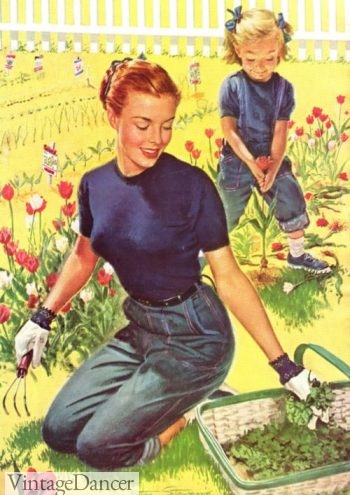
1950s Blue Jeans
1950s denim jeans, also called dungarees, were not quite as form-fitting as pants and capris.
1950s blue jeans were made of heavy dark denim fabric and lined with a vibrant plaid flannel that fit high on the waist, wide over the hips, and tapered down to the ankle or rolled / folded up to a wide cuff at mid calf (pedal pusher length).
Extra large pockets were a carryover from the 1940s, but in the 1950s the trend was to double outline seams and pockets in white stitching.
About half of 1950s women’s jeans were sold with a size zipper while the other half were mannish with a zipper fly. Jeans with flys were “western style” or “riders” vs fashion jeans that had size zippers and smooth front.
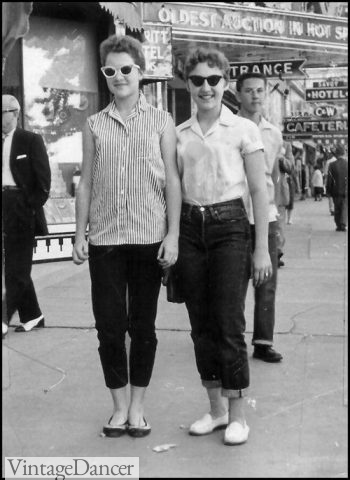
Women Wearing Denim Blue JeansAdding decorative trim to pocket openings that matched the lining exposed on plaid cuffs was an extra bit of fun 50s fashion, too.
Popular 1950s jeans brands were Levi’s 501’s as well as Blue Bell Wranglers. Kerrybrooke was the name of jeans sold in Sears catalogs and stores. Other department stores had their own brand names. It didn’t matter to women in the 1950s what brand they wore as long as they were comfortable.
1950s denim jeans were only worn for workwear, gardening, weekends, casual occasions, or on a rustic vacations, like camping.
- 1953 blue jeans and western pants
- 1957 denim jeans
Skinny jeans were the most feminize style of denim jeans. Not to be confused with modern stretch skinny jeans, 1950s slim fit jeans fit snugly around the hip and tapered narrowly down tot he ankle.

1950s slim jeans
Teenagers developed their own style with pants that differed from their mother’s. Teens, of course, might have rebelled and worn jeans out with friends on a Saturday afternoon, but never to school. They also liked to wear jeans a little tighter.
The classic 1950s teenager girl outfit was denim jeans with a white or plaid blouse, thick white bobby socks, and a pair of penny loafers or saddle shoes. In the late 50s the basic black flat replaced loafers.
- Early 1950s, Teens in Jeans and Sloppy Tops (Germany)
- Late 1950s Denim Jeans and a Western Shirt with Black Ballet Flats – an Iconic ’50s Look worn by Anne Francis 1954
Extra loose pants in the early years and extra slim pants worn with ballet flats, short cropped hair, and very baggy “Sloppy Joe” sweaters in the later years created a bohemian artist look.
In Europe, Teddy Girls mimicked this style with rolled cuff baggy jeans, flat shoes, black knit shirts and long blazers.
Naturally, parents hated the teenage girl style.
Learn more about the history of vintage blue jeans here.
1950s Western Pants
The ’40s and ’50s obsession with all things Western life extended into women’s pants. Not just for riding horses anymore, women living the western California lifestyle wore western motif slacks and western shirts as everyday casuals.
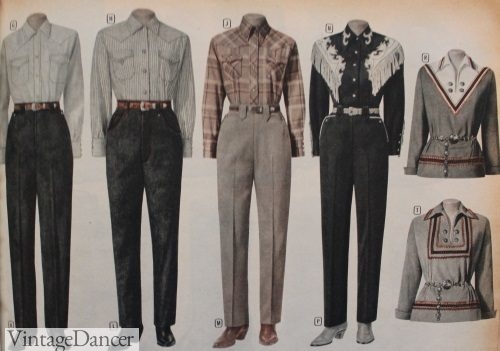
1955 Women’s western wear
1950s western jeans appeared in the same cut as other women’s slacks, with a tapered leg from hip to ankle. The western style came in with wide belt loops (and a western leather belt), white piping on the pockets, and sometimes rhinestone decorations for a fancy Western flair.
Learn more about 1930s-1950s Western fashion.
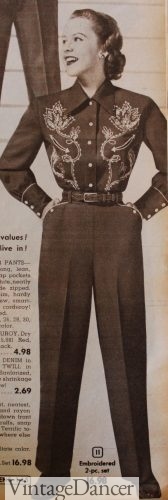
1953 Western Pants with White Piping around Pockets
‘Wrangler’ brand jeans made their mark on ’50s fashion. Heavy Blue Bell wrangler denim jeans featured a ‘wrangler’ front fly (oh my!). They also had large pockets on the back, and a smaller change pocket on the front that was mostly for looks. Classic Wranglers today don’t differ too much from the 1950s style.
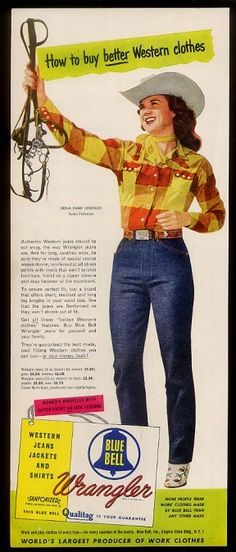
1951 Wrangler Blue Bell Jeans
Read More
- Women’s 1950s Shorts and Summer Wear
- 1950s Women’s Tops and Blouse Styles
- 1920s-1950s Vintage Camping and Hiking Clothes for Women
1950s Pants and Jeans Today
Fortunately, 1950s style pants are in fashion again. While capris are a summertime staple, high waist jeans are now also making a comeback. Plus, there are many ‘50s reproduction clothing brands that are making pants, capris and jeans, too.
My favorite place to find ’50s style pants are with brands that target mature women. They are usually high waisted, side zipping, colorful capris and slacks that look nearly identical to vintage ’50s pants.
I gathered up many of these 1950s inspired pants styles on the 1950s style pants shop page here:


